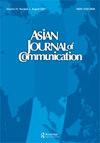Online intercultural education and study abroad: theory into practice
IF 1.5
2区 文学
Q2 COMMUNICATION
引用次数: 1
Abstract
Globally, there were more than 5.3 million international students in 2018, up from 2 million in 2000 (UNESCO, 2019). In 2018, China, as one of the prominent countries recognized for the active promotion of international education, sent more than 660, 210 students overseas for advanced studies. The increasing focus on education internationalization and studying abroad draws more and more attention to scholarships on intercultural education. In this book, the author Dr. Jane Jackson, explicitly putting theory into practice, addresses the problem of how overseas students improve their intercultural competence during their studies in the host environment through the intervention of online intercultural education to enrich their sojourn learning experience and its influence after they return to the motherland. She suggests that the practice-inspired online intercultural education could also promote global citizenship and meaningful intercultural dialogues. For overseas exchange program administrators, routine practitioners, novice and experienced intercultural education researchers, this book provides valuable guidance on how to conduct an empirical study on intercultural education, especially through the use of online digital technologies. Online Intercultural Education and Study Abroad: Theory into Practice consists of three parts. The first part (Chapter 1 to Chapter 3), covers the literature review, the design and development of the online course titled “Intercultural Communication and Engagement Abroad” as well as the rationale for conducting the ethnographic investigation of the online course. The second part (Chapter 4 to Chapter 7) focuses on the four major participants from her university, the Chinese University of Hong Kong in the ethnographic study. The last part, (Chapters 8 and 9) concludes with the findings and implications of the research. Then, some of the internal and external elements especially relevant to sojourn learning, such as the personality of the students and the environment of the host countries, are presented. The author says: “It is essential for intercultural educators to have some knowledge of these dimensions when designing and implementing a pedagogical intervention in a study abroad context” (p. 10). She argues that without understanding the nature of the cultural environment and some form of pedagogical intervention, overseas students may not fully benefit from their study abroad. The intercultural intervention should be a much closer connection between research and practice in the study abroad program to optimize the overseas experience with mentorship or coaching guidance (p. 14). Specifically, in Chapters 2 and 3, Professor Jackson presents the theoretical frameworks and methodology of the study. The theoretical frameworks are based on Hammer’s (2012) intercultural development continuum theory, Mezirow’s (2000) transformative learning theory, and Kolb’s (2015) experiential learning theory. The intercultural competence development process may be viewed as a continuous learning process with deep reflections (p. 32). After the introduction of the rationale of the study, the author unfolds the details of the course design, including the learning goals, course content, weekly themes, learning materials, activities, the eLearning platform and assessment. In Chapter 3, following the在线跨文化教育与海外学习:理论到实践
2018年,全球有530多万国际学生,高于2000年的200万(联合国教科文组织,2019年)。2018年,中国作为公认的积极推进国际教育的突出国家之一,向海外派遣了660210多名学生进行深造。随着人们对教育国际化和留学的日益关注,跨文化教育奖学金越来越受到关注。在这本书中,作者简·杰克逊博士明确地将理论付诸实践,解决了海外学生如何通过在线跨文化教育的干预来提高他们在东道国学习期间的跨文化能力,以丰富他们的旅居学习体验及其在返回祖国后的影响。她建议,这种受实践启发的在线跨文化教育也可以促进全球公民身份和有意义的跨文化对话。对于海外交流项目管理人员、常规从业者、新手和经验丰富的跨文化教育研究人员来说,本书为如何进行跨文化教育的实证研究,特别是通过使用在线数字技术,提供了宝贵的指导。网络跨文化教育与留学:理论与实践由三部分组成。第一部分(第1章至第3章),包括文献综述、题为“海外跨文化交流与参与”的在线课程的设计和开发,以及对在线课程进行民族志调查的基本原理。第二部分(第四章至第七章)主要介绍香港中文大学民族学研究的四位主要参与者。最后一部分(第8章和第9章)总结了本研究的发现和启示。然后,介绍了一些与旅居学习特别相关的内部和外部因素,如学生的个性和东道国的环境。作者说:“跨文化教育工作者在设计和实施留学背景下的教学干预时,必须了解这些方面的知识”(第10页)。她认为,如果不了解文化环境的性质和某种形式的教学干预,海外学生可能无法从海外学习中充分受益。跨文化干预应该在留学项目的研究和实践之间建立更紧密的联系,以通过导师或辅导指导优化海外体验(第14页)。具体而言,在第2章和第3章中,Jackson教授介绍了该研究的理论框架和方法。理论框架基于Hammer(2012)的跨文化发展连续体理论、Mezirow(2000)的变革性学习理论和Kolb(2015)的体验式学习理论。跨文化能力的发展过程可以看作是一个具有深刻反思的持续学习过程(第32页)。在介绍了研究的基本原理后,作者展开了课程设计的细节,包括学习目标、课程内容、每周主题、学习材料、活动、电子学习平台和评估。在第3章中,按照
本文章由计算机程序翻译,如有差异,请以英文原文为准。
求助全文
约1分钟内获得全文
求助全文
来源期刊

Asian Journal of Communication
COMMUNICATION-
CiteScore
3.70
自引率
0.00%
发文量
38
期刊介绍:
Launched in 1990, Asian Journal of Communication (AJC) is a refereed international publication that provides a venue for high-quality communication scholarship with an Asian focus and perspectives from the region. We aim to highlight research on the systems and processes of communication in the Asia-Pacific region and among Asian communities around the world to a wide international audience. It publishes articles that report empirical studies, develop communication theory, and enhance research methodology. AJC is accepted by and listed in the Social Science Citation Index (SSCI) published by Clarivate Analytics. The journal is housed editorially at the Wee Kim Wee School of Communication and Information at Nanyang Technological University in Singapore, jointly with the Asian Media Information and Communication Centre (AMIC).
 求助内容:
求助内容: 应助结果提醒方式:
应助结果提醒方式:


